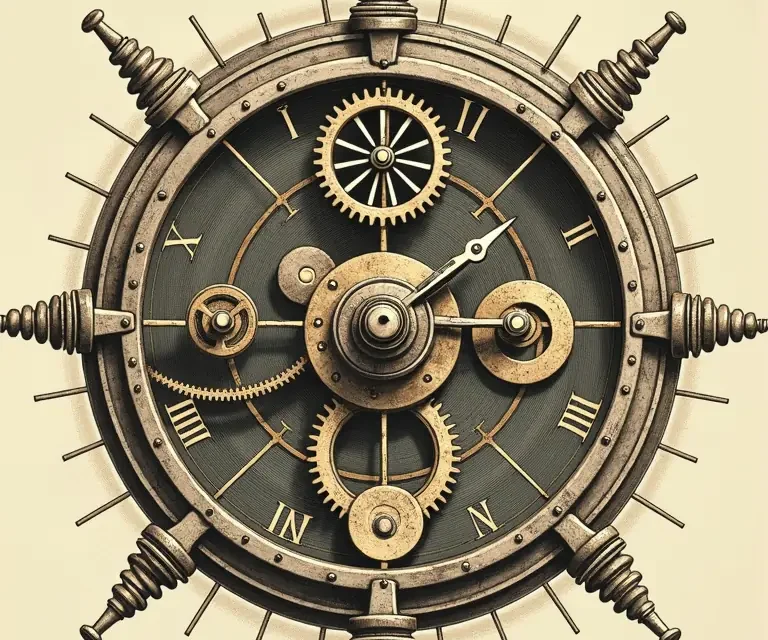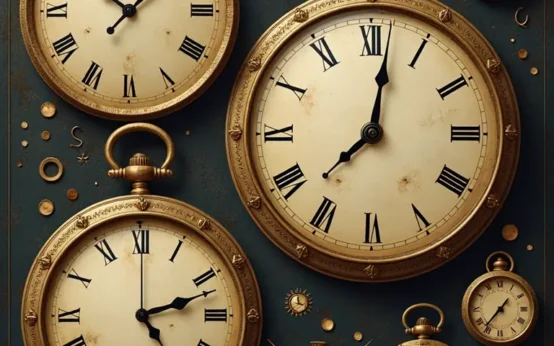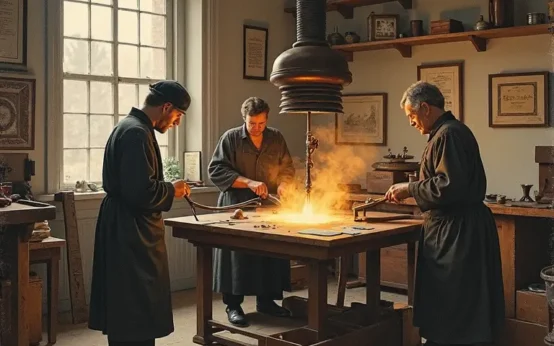For centuries, the melodic peal of clock chimes has marked the passage of time, evoking feelings of nostalgia, tradition, and even a touch of magic. But beyond the aesthetic appeal lies a surprisingly consistent science – a blend of mathematics, physics, and musical harmony that has evolved over generations. This article delves into the fascinating world of clock chimes, exploring their history, the principles governing their sound, and the subtle artistry that goes into their creation. We’ll uncover why certain chime sequences are so pleasing to the ear, and how the quest for accurate timekeeping has always been intertwined with the pursuit of beautiful sound.
A History Resonating Through Time
The story of clock chimes begins with the development of mechanical clocks in medieval Europe. The earliest mechanical clocks, appearing in the 14th century, were primarily functional – large, weighty devices installed in towers and cathedrals. Their primary purpose wasn’t to tell precise time (early clocks lacked minute hands!), but to announce the canonical hours, marking the times of prayer. These early ‘striking clocks’ didn’t initially feature melodic chimes; they simply struck a bell a certain number of times corresponding to the hour.
The transition to melodic chimes was a gradual process. The first attempts involved complex arrangements of hammers striking different sized bells, attempting to create rudimentary tunes. However, achieving harmonious sounds was challenging. The quality of metalworking, the tuning of bells, and the mechanical complexity of the striking mechanism all played crucial roles. The development of the verge escapement, a key innovation in clockmaking, enabled more precise timekeeping and, crucially, more sophisticated chime sequences.
By the 16th and 17th centuries, clockmakers began to explore more elaborate chime systems. The famous clocks of Augsburg, Germany, became renowned for their intricate automatons and complex musical chimes. These weren’t just timekeepers; they were mechanical spectacles. The development of the carillon – a musical instrument consisting of at least 23 bells – further refined the art of chiming. Carillons, often found in towers, are capable of playing intricate melodies.
The 18th and 19th centuries saw the widespread adoption of chiming clocks in homes, though usually in a more simplified form than the grand carillons. The Westminster Quarters, arguably the most recognizable chime sequence globally, gained prominence during this period, becoming a standard feature in clocks manufactured in England and beyond. The story of its origin is tied directly to the iconic clock at the Houses of Parliament, which we’ll discuss further below.
The Physics of Sound: Why Bells Ring True
Understanding why certain chime sequences sound pleasing requires a grasp of basic physics. Sound, fundamentally, is a vibration that travels through a medium, like air. The frequency of the vibration determines the pitch of the sound – higher frequency means higher pitch. The amplitude of the vibration determines the loudness. Bells, when struck, vibrate in complex patterns, producing not just a fundamental frequency but also a series of overtones (also called harmonics).
The overtones are what give each bell its unique timbre – its characteristic sound quality. A bell’s shape, size, thickness, and the metal composition (typically bronze, an alloy of copper and tin) all influence the frequencies of these overtones. A well-tuned bell will have overtones that are mathematically related to the fundamental frequency, creating a harmonious sound. Discordant sounds arise when the overtones are not harmonically related.
Clock chimes rely on the principle of consonance and dissonance. Consonance refers to intervals between notes that sound pleasing together, while dissonance refers to intervals that sound harsh or unstable. The most consonant intervals are typically based on simple ratios – for example, an octave (2:1), a perfect fifth (3:2), and a perfect fourth (4:3). Chime sequences are carefully constructed to emphasize consonant intervals and minimize dissonance, creating a sense of musical harmony.
The act of striking a bell also impacts its sound. The location and force of the hammer strike influence the excitation of different vibrational modes within the bell, altering the relative strengths of the overtones. A skilled clockmaker carefully adjusts the hammer mechanism to optimize the bell’s sound.
The Mathematics of Harmony: Scales, Intervals, and the Chime
The mathematical relationships underlying musical harmony have been explored for millennia, dating back to the ancient Greeks. Pythagoras, in the 6th century BC, discovered the mathematical ratios that govern consonant intervals. These ratios form the basis of musical scales – ordered sets of notes that define a key.
Clock chimes often utilize diatonic scales – seven-note scales that are characteristic of Western music. The Westminster Quarters, for instance, is based on the C major scale. The sequence consists of four notes played over four quarter-hour intervals. The notes are chosen to create a pleasing harmonic progression. The exact notes played vary depending on the hour, but they always adhere to the principles of consonance and dissonance within the C major scale.
Other chime sequences employ different scales and intervals. Some clocks utilize pentatonic scales (five-note scales), which are common in many cultures and tend to sound particularly harmonious. The choice of scale and intervals significantly impacts the overall character of the chime.
The Westminster Quarters: A Case Study in Chime Design
The Westminster Quarters chime, the most widely recognized chime sequence in the world, originated from the Great Clock at the Palace of Westminster (Houses of Parliament) in London. The clock, designed by Edmund Beckett Denison and completed in 1859, was a landmark achievement in Victorian engineering. The chime sequence was composed by Edmund Beckett Denison himself, drawing inspiration from a Cambridge Quarters chime.
The Westminster Quarters chime is unique in that it doesn’t simply play the hour. Instead, it plays a different sequence of notes for each quarter-hour. Here’s the breakdown:
- On the hour: The number of chimes corresponds to the hour (e.g., 10 chimes at 10 o’clock).
- First quarter-hour: Four notes (E, G#, A, B)
- Second quarter-hour: Four notes (E, G#, C, D)
- Third quarter-hour: Four notes (G#, A, B, C)
- Fourth quarter-hour: Four notes (A, B, C, D)
The brilliance of the Westminster Quarters lies in its subtle variations. The changing sequences prevent the chime from becoming monotonous, while still remaining firmly rooted in the C major scale. The use of the dominant 7th chord (G# major 7th) adds a touch of sophistication and harmonic interest.
The widespread adoption of the Westminster Quarters chime was largely due to its use in clocks manufactured by prominent clockmaking firms, such as Big Ben’s clockmaker, Thwaites & Reed. As these clocks were exported around the world, the chime sequence became increasingly familiar and associated with traditional British timekeeping.
Beyond Westminster: Exploring Other Chime Traditions
While the Westminster Quarters is the most famous, numerous other chime traditions exist. The Whittington chime, named after the legendary merchant Richard Whittington, is a traditional chime sequence used in many clocks in England, particularly in London. It consists of a simple series of five notes and is often associated with the bells of St. Mary-le-Bow church.
In Germany, carillons often play elaborate melodies, ranging from classical pieces to folk tunes. The St. Peter’s Church in Cologne boasts a renowned carillon with 49 bells, capable of playing a vast repertoire. Other countries have their own unique chime traditions, reflecting local musical styles and cultural preferences.
The Modern Clock and the Future of Chimes
The advent of digital clocks and electronic chimes has introduced new possibilities for sound design. While traditional mechanical chimes continue to be cherished for their authenticity and craftsmanship, digital chimes offer greater flexibility and customization. It’s now possible to create chime sequences that incorporate a wider range of instruments, harmonies, and even sound effects.
However, there’s a growing appreciation for the artistry of traditional clockmaking. The mechanical complexity and acoustic properties of well-crafted chiming clocks are seen as a testament to human ingenuity. Restoring and preserving these historical instruments is an important endeavor. The skills required to build and maintain these clocks are becoming increasingly rare, making them valuable cultural artifacts.
Furthermore, the principles governing harmonious chimes remain relevant even in the digital age. Sound designers can apply the same mathematical and musical principles to create digital chimes that are pleasing to the ear. The quest for beautiful and meaningful sound, it seems, is a constant in the evolution of timekeeping.
The Interconnectedness of Disciplines
The science of clock chimes beautifully illustrates the interconnectedness of seemingly disparate disciplines. It draws upon physics to understand the behavior of sound, mathematics to define harmonic relationships, music theory to create pleasing melodies, and engineering to build the mechanisms that bring it all to life.
This interconnectedness extends beyond these core fields. The history of clock chimes is intertwined with social and cultural developments, reflecting changing tastes and technological advancements. The materials used in clockmaking – bronze, steel, wood – are products of metallurgy, woodworking, and other crafts. Even the artistic decoration of clocks reflects the aesthetic trends of their time.
This holistic perspective is valuable in understanding the broader context of technological innovation. It reminds us that progress is rarely linear and often arises from the convergence of multiple fields of knowledge and skill.
If you’re fascinated by the intricate ways animals navigate, you might find similarities in the underlying principles of pattern recognition and sensory integration in the science of bird migration. Similarly, the historical tracking of origins, as seen in the etymology of food names, shares a focus on tracing the roots of established systems.
The precision required in clockmaking echoes the attention to detail found in the science of knot strength, where structural integrity relies on carefully calculated tensions and geometries. The dedication to preservation and intricate detail also finds parallels in Victorian hairwork, a craft demanding patience and meticulous skill. Finally, the exploration of symbolic meaning within patterns – like those found in chime sequences – resonates with the science of dream interpretation, which seeks to decode the hidden messages within our subconscious.
Here’s a visual representation of a chemical clock reaction, showcasing the beauty of predictable changes over time, much like the consistent rhythm of a clock chime:
The seemingly simple act of listening to clock chimes connects us to a rich history of scientific inquiry, artistic expression, and cultural tradition. It’s a reminder that even in our increasingly digital world, there’s still beauty and wonder to be found in the tangible, mechanical world around us.


 The Curious Acoustics of Historical Echo Chambers: Resonance, Ritual, and Revelation
The Curious Acoustics of Historical Echo Chambers: Resonance, Ritual, and Revelation  The Curious Kinship of Clocks and Calendars: A History of Time’s Dual Measurement
The Curious Kinship of Clocks and Calendars: A History of Time’s Dual Measurement  The Curious Cartography of Scent: Mapping Perfume Ingredients Through History
The Curious Cartography of Scent: Mapping Perfume Ingredients Through History  The Curious Lexicon of Lost Trades
The Curious Lexicon of Lost Trades  The Surprisingly Consistent Science of Historical Ice Harvesting – A Frozen History of Commerce & Preservation
The Surprisingly Consistent Science of Historical Ice Harvesting – A Frozen History of Commerce & Preservation  The Unexpectedly Consistent Science of Historical Buttonhooks – Fashion, Function & Forgotten Tools
The Unexpectedly Consistent Science of Historical Buttonhooks – Fashion, Function & Forgotten Tools